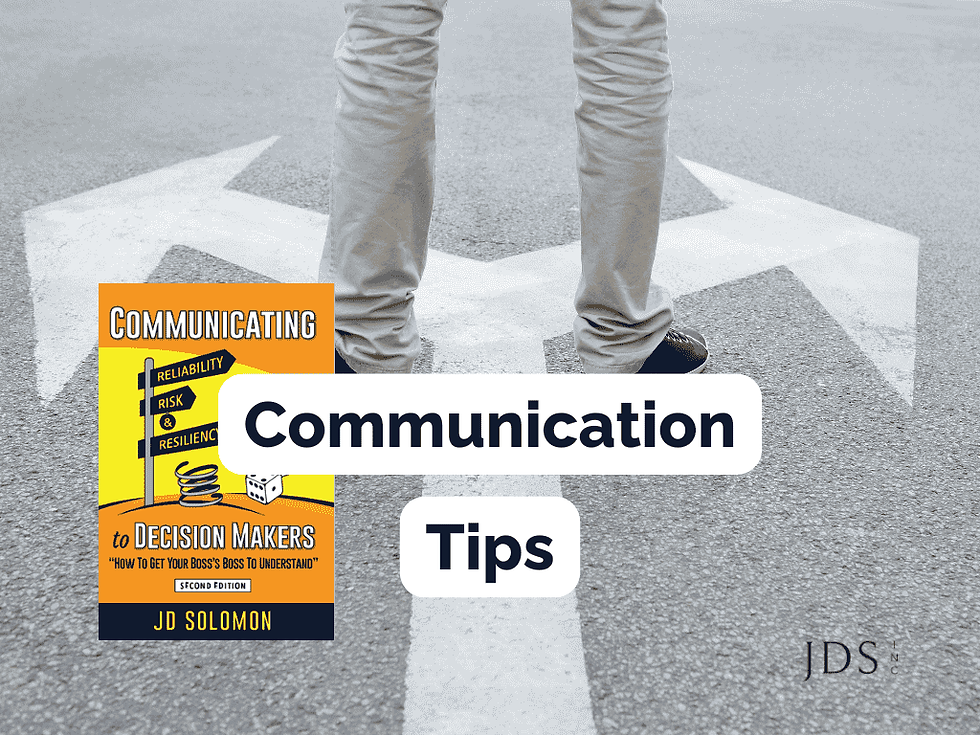Less than Obvious Tips That Will Boost Your Project Milestone Reviews
- JD Solomon

- Dec 21, 2022
- 5 min read
Updated: Jun 16, 2024

Four basic things to improve project milestone reviews
Autopsies and Improving the Dreaded Project Milestone Review provides insights and four basic things to improve project milestone reviews:
Do not do a milestone review on every task.
Approach the milestone review with a positive attitude.
Seek an experienced facilitator.
Allow ample time.
Remember, we want to break the program into parts just like an autopsy, but the participants do not need to feel like they have been on the slab. And no one should call the funeral home when the milestone review is done.
An average autopsy case takes about four hours, including the paperwork. Milestone reviews are similar.
Communication is Important
A milestone review is a facilitated session. Unfortunately, we often approach milestone reviews as just another meeting.
The cause and effect relationships in the FINESSE fishbone diagram apply to effectively communicating at a milestone meeting. The seven bones are Framing, Illustrations, Noise reduction, Empathy, Structure, Synergy, and Ethics. The Five Reasons Being An Effective Communicator Helps Your Technical Career will also help your milestone reviews.
Less than Obvious Tips
1. The Project Charter Consistently Pays Dividends
The benefits of a formal project charter should be obvious to all project managers; however, in practice, this is not the case.
A project charter is a short document that outlines the entirety of the project. It includes the project mission, goals, deliverables, tasks, timelines, roles & responsibilities, performance measures, and stakeholders. The Project Management Institute’s PMBOK Guide (and other best practice standards) describe it as an essential deliverable t and one of the first deliverables in every project.
The primary benefit of a project charter is that it sets the working contract between team members rather than following the legal contract between all parties. Legal contracts should be modified if they are not in alignment with the collective direction of the project.
2. A Synthesis Document Prevents Backsliding
A synthesis document aims to combine a number of different pieces into a whole. The document includes all of the relevant decisions, work products approved by project participants, points of contention, project performance metrics, and supporting information that will facilitate everything into final form. It is more detailed than a decision log and much more concise than a SharePoint site.
In practice, a synthesis document progressively builds into a final form that lets the project team know they are finished.
The synthesis document identifies conflicts early and often. The document also prevents re-opening decisions or backsliding from previous agreement points.
3. Make It Interactive
The typical milestone review centers on a Gantt chart that describes the tasks, their dependencies, and timelines. The project controls function usually brings in reams of papers or crushing PowerPoint slides. Although the official tools to analyze and report on the schedule, budget, and quality are necessary, the entire meeting does not need to be aligned with these energy-sucking elements.
All of this information should be provided to participants in advance. The first ten to fifteen minutes of the milestone meeting should be devoted to quiet time for the participants to read the information. Getting the material in advance and allowing time to review it provides the opportunity for a more interactive review.
There is no need, and it is disrespectful, to read basic information to trained professionals. Use your valuable time together for a more beneficial purpose.
The primary benefit of group interaction is that critical thinking can be applied to issues like quality and risk.
4. Avoid a Beat-Down Session
By their nature, milestone reviews identify gaps. However, the event's primary purpose is to provide the team with project status and frame potential corrective action. Most corrective actions cannot be finalized in the meeting because the actions require some re-allocation of resources that, in turn, require senior management approval.
Remember that an autopsy should not make those participating in it think they were on the slab.
The benefit of avoiding a beat-down session is continued energy for the project, subsequent milestone reviews, and a successful end product.
5. The Follow-Up Is Critical
Most of us are happy when the milestone meeting is over. We wait for the project manager to send us the notes and the updated project control documentation. Then we more or less keep doing things the way we did before the milestone review.
One useful practice is to set multiple meetings related to key tasks over the next two weeks while in the milestone meeting. The big stuff is obvious, but here we are including some of the small stuff, too. For the project manager, success can be described as being busier in the two weeks after the meeting than they were in the two weeks preparing for it.
The benefit is that creative thinking continues. Some things that seemed small in the milestone meeting were actually swamped by the larger issues. Better clarification and improved solutions will be gained in the aftermath.
Three End-of-Year Examples
A recent major infrastructure project had a milestone review that went below average. The session was cold, stale, and limited progress toward getting some milestone activities on track. I attribute it to a project manager and an executive sponsor who continued doing things they always had and did not spend much time making the review more productive. This one gets a ragged C.
Another recent example comes from a multi-year asset management project. The project manager was fully engaged, and the creative executive sponsor was present throughout the milestone review. The participants used the master schedule and project charter as the basis of the meeting but focused the meeting on interactive and avoided any beat-downs (although two were probably in order). The information was provided to participants in advance. The follow-up meetings are aggressive and in progress. This one gets a high B.
A third example is related to a multi-year planning project. The project manager and executive sponsor are fully engaged. Both rely on their team of subject matter experts and facilitators to be creative. A charter and a synthesis document guide the process. All information for the milestone review was provided the week before the session. The session was highly interactive and productive. This one gets a solid A.
Putting It into Practice
Improving milestone reviews involves doing the basics well while avoiding some less obvious aspects that undermine effectiveness. Project managers who seek to excel by practicing these tips will keep their projects on track. Moreover, they will keep their team members coming back and off the autopsy slab.
JD Solomon Inc. provides solutions for program development, facilitation, and asset management at the nexus of facilities, infrastructure, and the environment. Contact us if you are looking for more effective approaches to program development and program management services.
Founded by JD Solomon, Communicating with FINESSE is a not-for-profit community of technical professionals dedicated to being better trusted advisors. Join the community for free.










Comments